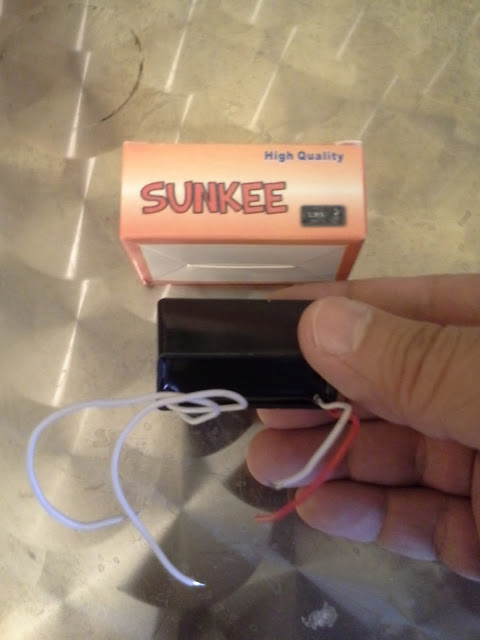SUNKEE DC 3V to 7KV 7000V Boost Step-up Power Module High-voltage Generator
3.4V DC in 7000V DC out!
I have a huge, heavy neon sign transformer (NST) that puts out 5000 volts (5kV) at 18 milliamps (0.018A) and this little box puts out a much scarier spark, although the this doesn't seem to travel through stiff wires so I couldn't make a mini Jacob's Ladder out of it (yet). I'm thinking that means it has very low amps...I haven't measured it yet (use a high voltage divider probe or else you'll wreck your multimeter).
One side has 2 white (or red) wires: those are your outputs. Mine has 2 white outputs.
The input side will have two DIFFERENT color wires (1 red and 1 white). You have to hook positive input to the red. Hook negative input to the white.
In my photo the tips of the output wires are exactly 1/4" apart. The input voltage was 3.3 volts DC. The spark was loud, blue and awesome! Very crackly like a stun gun in the movies. I built a demo fusor (and made the Plasma Club) yet this seems scarier!
You must input DC voltage. You probably shouldn't go over too high or so, although I did momentarily and got a huge spark. The specs say 3 volts. I needed 3.4 to get a steady spark. I'll update if I blow it up and I'll include the final voltage.
If you have the wires farther than 1/4" then either it won't spark or you'll crank up the voltage really high to get a spark: either way you might destroy this device.
If you apply voltage and don't provide an escape for it (a spark or powering something) you can destroy this unit. That's another danger of trying to make a bigger spark gap: you'll be powering this unit but if there's no spark you can destroy this unit apparently. I think that's what the advert means by "don't let the pressure build up" meaning to keep it under load.
For about the price of a single firework you can play with this. I haven't destroyed mine yet. It fills the room with ozone quickly (toy train / slot car smell).
Get a sturdy holder apparatus for the output wires so you don't die.
It came in a cute box, but no instructions other than to keep it away from static. I have a feeling that if you rubbed this on a static wool sweater you might kill yourself with it.
Not bad for $7 on Amazon!
So, besides making the world's tiniest Jacob's Ladder what else did I make with it? An alpha particle spark detector!
Yep, just dial down the input voltage until the sparks sputter out. Then I moved a piece of radioisotope AM-241 (Americium) close to the L-shaped wires. ZAP! The alpha particles get ionized between the 7000 volts of awesomeness.
Check out my previous posts on a bunch of other alpha particle spark detectors, ionizing radiation chambers, nuclear cloud chambers and general Geiger counters.
Another neat thing about the electric arcs generated by this setup is that it reads incredibly COLD on my infrared thermometer! I'm not sure why. Here is my current guess before researching:
Theory 1: the sparks create ozone gas. Ozone has low emissivity: it absorbs infrared radiation. Gases (and dusty conditions) also give false low reading for IR thermometers as well. They gaseous ozone doesn't let the infrared radiation travel to the thermometer: the result is an ultra cold reading.
This is similar to how the sky will look utterly black through infrared heat cameras.
Theory 2: it is known that electromagnetic waves in excess of 3 volts per meter at 90-360 MHz will interfere with IR thermometers. I've got 3.4 volts DC turning into 7000 volts of fast pulsing sparks.
Theory 3: maybe the emissivity of the sparks are similar to that of shiny metal: terribly low. Simple IR thermometers are set to .95 emissivity. Spray paint a piece of aluminum super velvet-black and it will approach 1.0 emissivity. Shine that aluminum with steel wool and it will drop to around 0.003 emissivity! Basically invisible to the IR thermometer.


